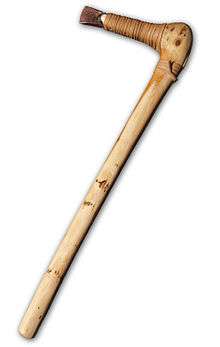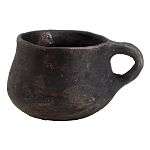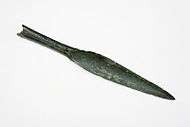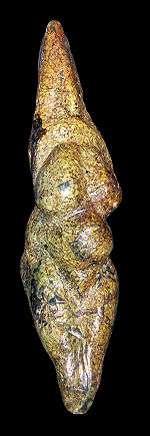Prehistoric Italy
Part of a series on the |
|---|
| History of Italy |
 |
|
|
|
|
|
|
The prehistory of Italy begins with the arrival of the first hominids 850,000 years ago in northern Italy at Monte Poggiolo[1] and ends in the Iron Age, when the first written records appeared in the peninsula.
Paleolithic
In prehistoric times, the Italian peninsula was rather different from how it is now. During glaciations, for example, the sea level was lower and the islands of Elba and Sicily were connected to the mainland. The Adriatic Sea began at what is now the Gargano Peninsula, and what is now its surface up to Venice was a fertile plain with a humid climate.
The arrival of the first hominins was 850,000 years ago at Monte Poggiolo.[1] The presence of Homo neanderthalensis has been demonstrated in archaeological findings dating to c. 50,000 years ago (late Pleistocene). There are some twenty such sites, the most important being that of the Grotta Guattari at San Felice Circeo, on the Tyrrhenian Sea south of Rome. Other are the grotta di Fumane (province of Verona) and the Breuil grotto, also in San Felice.
The first Cro Magnon inhabitants of Italy moved across the peninusula, establishing themselves in small settlements far from each one, most on high areas. In November 2011 tests conducted at the Oxford Radiocarbon Accelerator Unit in England on what were previously thought to be Neanderthal baby teeth, which had been unearthed in 1964 from the Grotta del Cavallo, dated teeth from between 43,000 and 45,000 years ago.[2]
In 2011 it has been discovered the most ancient Sardinian complete human skeleton (called Amsicora) at Pistoccu, in Marina di Arbus; scientists date it to 8500 years ago (the transition period between the Mesolithic and Neolithic).[3]
Neolithic
Cardium Pottery is a Neolithic decorative style that gets its name from the imprinting of the clay with the shell of the Cardium edulis, a marine mollusk. The alternative name Impressed Ware is given by some archaeologists to define this culture, because impressions can be with sharp objects other than Cardium shell, such as a nail or comb.[4]


Impressed Ware is found in the zone "covering Italy to the Ligurian coast" as distinct from the more western Cardial beginning in Provence, France and extending to western Portugal.
This pottery style gives its name to the main culture of the Mediterranean Neolithic, which eventually extended from the Adriatic sea to the Atlantic coasts of Portugal and south to Morocco.[5]
Since the Late-Neolithic, Aosta Valley, Piedmont, Liguria, Tuscany and Sardinia in particular were involved in the pan-Western European Megalithic phenomenon. Later, in the Bronze Age, megalithic structures were built also in Latium, Puglia and Sicily.[6] This latter region, around the end of the third millennium B.C. imported from Sardinia typical cultural aspects of Atlantic world, including the Culture of small dolmen-shaped structures that reached all over the Mediterranean basin.[7]

Copper Age
The Remedello, Rinaldone and Gaudo cultures are late Neolithic cultures of Italy, traces of which are primarily found in the present-day regions of Lombardy, Tuscany, Latium and Campania. They are sometimes described as Eneolithic cultures, due to their use of primitive copper tools. Other importants eneolithic cultures of the peninsula and the islands, often related to those previously mentioned, are the Laterza culture in Apulia and Basilicata, the Abealzu-Filigosa culture in Sardinia, the Conelle-Ortucchio culture in Abruzzo and Marche, the Serraferlicchio culture in Sicily, and the Spilamberto group in Emilia-Romagna.
The earliest Statue menhirs, frequently depicting weapons, were erected by the populations of northern Italy and Sardinia during this period. This sculptural tradition of possible steppe origin (Yamna culture),[8] lasted in some regions well into the Bronze Age and even into the Iron Age.[9]
The Beaker culture marks the transition between the Eneolitichic and the early Bronze Age.
.png)
Bronze Age
Polada culture

The Polada Culture (a location near Brescia) was a cultural horizon extended from eastern Lombardy and Veneto to Emilia and Romagna, formed in the first half of 2nd millennium BC perhaps for the arrival of new people from the transalpine regions of Switzerland and Southern Germany.
The settlements were usually made up of stilt houses; the economy was characterized by agricultural and pastoral activities, hunting and fishing were also practiced as well as the metallurgy of copper and bronze (axes, daggers, pins etc.). Pottery was coarse and blackish.[10]
It was followed in the Middle Bronze Age by the facies of the pile dwellings and of the dammed settlements.
Nuragic civilization
Located in Sardinia (with ramifications in southern Corsica), the Nuragic civilization, who lasted from the early Bronze Age (18th century B.C.) to the second century A.D. when the island was already Romanized, evolved during the Bonnanaro period from the preexisting megalithic cultures that built dolmens, menhirs, more than 2,400 Domus de Janas and also the imponent altar of Monte d'Accoddi.
It takes its name from the characteristic Nuraghe. The nuraghe towers are unanimously considered the best-preserved and largest megalithic remains in Europe. Their effective use is still debated; while most scholars considered them as fortresses, others see them as temples.
A warrior and mariner people, the ancient Sardinians held flourishing trades with the other Mediterranean peoples. This is shown by numerous remains contained in the nuraghe, such as amber coming from the Baltic Sea, small bronze figures portraying African beasts, copper nuggets and weapons from Eastern Mediterranean, Mycenaean ceramics. It has been hypothesized that the ancient Sardinians, or part of them, could be identified with the Sherden, one of the so-called People of the Sea who attacked ancient Egypt and other regions of eastern Mediterranean.
Other original elements of the Sardinian civilization include the temples known as "Holy wells", dedicated to the cult of the holy waters related to Luna and astronomical cycles, the Giants' graves, the Megaron temples, several structures for juridical and leisure functions and numerous bronze statuettes, which were discovered even in Etruscan tombs, suggesting a strong relationships between the two peoples. Another important element of this civilitation are the Giants of Mont'e Prama, perhaps the oldest anthropomorphic statues of the western Mediterranean sea.
Sicily
Among the most important cultural expressions born in Sicily during the Bronze Age the cultures of Castelluccio (Ancient Bronze Age) and of Thapsos (Middle Bronze Age) are worth noting. Both originated in the southeastern part of the island. In these cultures, in particular in the Castelluccio phase, there are obvious influences from the Aegean Sea, where the Helladic civilization was flourishing.
Belonging to a western (Iberian-Sardinian) type is the Bell Beaker culture known from sites on the northwestern and southwestern coasts of Sicily, previously occupied by the Conca d'Oro culture, while in the late Bronze Age there are signs in northeastern Sicily of cultural osmosis with the people of the peninsula that led to the appearance of Proto-Villanovan culture at Milazzo, perhaps linked to the arrival of Sicels.[11]
The nearby Aeolian Islands hosted the flourishing of the Capo Graziano and Milazzo cultures in the Bronze Age, and subsequently that of Ausonio (divided into two phases, I and II).[12]
Apennine culture
The Apennine culture is a cultural complex of central and southern Italy that, in its broadest sense (including the preceding Protoapennine B and following Subapennine facies), spans the Bronze Age. In the narrower sense more commonly used today, it refers only to the later phase of the Middle Bronze Age in the 15th and 14th centuries BCE.
The people of the Apennine culture were, at least in part, cattle herdsmen grazing their ungulates over the meadows and groves of mountainous central Italy, including on the Capitoline Hill at Rome, as shown by the presence of their pottery in the earliest layers of occupation. The primary picture is of a population that lived in small hamlets located in defensible places. There is evidence that herdsmen, when traveling between summer pastures, built temporary camps or lived in caves and rock shelters. However, their range was not confined to the hills, nor was their culture confined to herding cattle, as shown by sites like Coppa Nevigata, a well-defended and somewhat sizeable coastal site where a variety of subsistence strategies were practiced alongside advanced industries such as dye production.
Terramare

The Terramare was a Middle and Recent Bronze Age culture, between the 16th and the 12th centuries B.C., in the area of what is now Pianura Padana (specially along the Panaro river, between Modena and Bologna).[13] Their total population probably reached an impressive peak of 150,000 near the beginning of the Recent Bronze Age. In the early period they lived in villages with an average population of about 130 people living in wooden stilt houses: they had a square shape, built on land but generally near a stream, with roads that crossed each other at right angles. Over the lifetime of the Terramare culture, these settlements developed into stratified zones with larger settlements of up to 15-20Ha (approximately 1500-2000 people) surrounded by smaller villages. Especially in the later period, the proportion of settlements that were fortified approaches 100%.
It has been suggested that the Terramare of Emilia acted as stores and starting points for trades of the Baltic amber and the tin from Erzgebirge through the Val Camonica and the Po River, towards the Eastern Mediterranean Sea and Greece.
Around the 12th century BC the Terramare system collapsed, the settlements were abandoned and the populations moved southward, where they mingled with the Apennine peoples.[13] The influence of this population abandoning the Po valley and moving south may have formed the basis of the Tyrrhenian culture, ultimately leading to the historic Etruscans, based on a surprising level of correspondence between archeological evidence and early legends recorded by the Greeks.[13]
Castellieri
The Castellieri civilization developed in Istria during the Mid-Bronze Age, and later expanded into Friuli, the modern Venezia Giulia, Dalmatia and the neighbouring areas. It lasted for more than a millennium, from the 15th century BC until the Roman conquest in the 3rd century BC. It takes its name from the fortified boroughs (Castellieri, Friulian cjastelir) which characterized the culture.
The ethnicity of the Castellieri civilization is uncertain, although it was most likely of Pre-Indoeuropean stock, coming from the sea. The first castellieri were indeed built along the Istrian coasts and present the same Megalithic appearance characterizing in the Mycenaean civilization at the time. Hypotheses about an Illyrian origin of the people are not confirmed.
The Castellieri were fortified boroughs, usually located on hills or mountains or, more rarely (such as in Friuli), in plains. They were constituted by one or more concentric series of walls, of rounded or elliptical shape in Istria and Venezia Giulia, or quadrangular in Friuli, within which was the inhabited area.
Some a hundred of castellieri have been discovered in Istria, Friuli and Venezia Giulia, such as that of Leme, in the central-western Istria, of the Jelarji, near Muggia, of Monte Giove near Prosecco (Trieste) and San Polo, not far from Monfalcone. However, the largest castelliere was perhaps that of Nesactium, in the southern Istria, not far from Pula.
Canegrate culture
The Canegrate culture developed from the mid-Bronze Age (13th century BC) till the Iron Age in the Pianura Padana, in what is now western Lombardy, eastern Piedmont and Ticino. It takes its name from the township of Canegrate where, in the 20th century, some fifty tombs with ceramics and metal objects were found. It represents the first migratory wave of the proto-Celtic[14] population from the northwest part of the Alps that, through the Alpine passes, had already penetrated and settled in the western Po valley between Lake Maggiore and Lake Como (Scamozzina culture). They brought a new funerary practice—cremation—which supplanted inhumation.[15]
Canegrate terracotta is very similar to that known from the same period north to the Alps (Provence, Savoy, Isère, Valais, the area of Rhine-Switzerland-eastern France). The members of the culture have been described as a warrior population who had descended to Pianura Padana from the Swiss Alps passes and the Ticino.
Proto-Villanovan culture
Luco-Meluno culture
The Luco-Meluno culture originated in the transition period between the Bronze Age and the Iron Age and occupied Trentino and part of South Tyrol. It was succeeded, in the Iron Age, from the Fritzens-Sanzeno culture.
Iron Age
Villanova culture
The name of this Iron Age civilization derives from a locality in the frazione Castenaso of Bologna, in Emilia, where a necropolis was discovered by Giovanni Gozzadini in 1853-1856. It succeeded the Proto-Villanovan culture during the Iron Age in the territory of Tuscany and northern Lazio and spread in parts of Romagna, Campania and Fermo in the Marche
The main characteristic of the Villanovans (with some similarities with the so-called protovillanovian epoch of the late Bronze Age) were the incinerated sepultures, in which the dead's ashes were housed in double-cone shaped urns and buried. The burial characteristics relate the Villanovan culture to the Central European Urnfield culture (c. 1300–750 BC), and 'Celtic' Hallstatt culture (which succeeded the Urnfield culture).
The Villanovan were initially devoted to agriculture and breeding, with a simplified social order. Later, specialized craftmanship activities such as metallurgy and ceramics created an accumulation of richness, which caused the appearance of social stratification.
Latial culture
Este culture
Golasecca culture

The Golasecca culture developed starting from the early Iron Age in the northwestern Po plain. It takes its name from Golasecca, a locality next to the Ticino where, in the early 19th century, abbot Giovanni Battista Giani excavated its first findings (some fifty tombs with ceramics and metal objects). Remains of the Golasecca culture span an area of c. 20,000 square kilometers south to the Alps, between the Po, Sesia and Serio rivers, dating from the 9th to the 4th century BC.
Their origins can be directly traced from that of Canegrate and to the so-called Proto-Golasecca culture (12th-10th centuries BC). Recent excavations have proved the continuity of the culture after the Celtic invasion from France around 390/380 BC. The Golasecca culture traded with the Etruscans and the Halstatt culture on the north, later reaching the Greek world (oil, wine, bronze objects, ceramics and others) and northern Europe (tin and amber from the Baltic coast).
In a Golasecca culture tomb in Pombia has been found the oldest known remain of common hop beer in the world.
Fritzens-Sanzeno culture
The Camuni
The Camuni were an ancient people of uncertain origin (according to Pliny the Elder, they were Euganei; according to Strabo, they were Rhaetians) who lived in Val Camonica – in what is now northern Lombardy – during the Iron Age, although human groups of hunters, shepherds and farmers are known to have lived in the area since the Neolithic.
They reached the height of their power during the Iron Age due to the presence of numerous iron mills in Val Camonica. Their historical importance is, however, mostly due to their legacy of carved rocks, c. 300,000 in number, which date from the Palaeolithic to the Middle Ages.
Pre-Roman period

Among the populations of pre-Roman Italy, the most notable were the Etruscans who, starting from the 8th century BC, created a refined civilization which largely influenced Rome and the Latin world. The origins of this non-Indo-European people, which originated from the Tyrrhenian coast of central Italy and later expanded to northern Italy (Emilia in particular) and Campania, are uncertain.
Other peoples living in northern Italy include the Ligurians (an Indo-European people who lived in what is now Liguria, southern Piedmont and the southern French coast), and the Veneti of north-eastern Italy, who probably came from Illyria or, according to other studies, Asia Minor. Then arrived Celts. In the peninsula, alongside the Etruscans, lived numerous tribes, mostly of Indo-European origin: the Umbri in Umbria and northern Abruzzo, Latins, Sabellians, Falisci, Volsci and Aequi in the Latium; Piceni in the Marche and north-east Abruzzo; Samnites in southern Abruzzo, Molise and Campania; Daunians, Messapii and Peucetii (forming the Apulian or Iapygian confederation) in Apulia; Lucani and Bruttii in the southern tips of the peninsula. Sicels, Elymians and Siculi in Sicily. Then arrived Greek. Sardinia was still inhabited by the Nuragic peoples. Then arrived Phoenicians. Latins created the Roman civilization.
See also
Notes
- 1 2 National Geographic Italia - Erano padani i primi abitanti d’Italia(Italian)
- ↑ Wilford, John Noble (2 Nov 2011). "Fossil Teeth Put Humans in Europe Earlier Than Thought". New York Times. Retrieved 2012-04-19.
- ↑
- ↑ "Impressed Ware Culture". The Concise Oxford Dictionary of Archaeology. Retrieved 2008-05-11.
- ↑ Antonio Gilman, Neolithic of Northwest Africa, Antiquity,vol 48, no. 192 (1974), pp 273-282.
- ↑ Artepreistorica.com - MEGALITISMO DOLMENICO DEL SUD-EST ITALIA NELL´ETA´ DEL BRONZO(Italian)
- ↑ Salvatore Piccolo (2013), Ancient Stones: The Prehistoric Dolmens of Sicily. Abingdon/GB, Brazen Head Publishing, ISBN 978-09-56510-62-4.
- ↑ Francesco Fedele - La società dell’età del Rame nell’area alpina e prealpina(Italian)
- ↑ Museo delle Statue Stele Lunigianesi - Le statue stele in Italia e in Europa(Italian)
- ↑ Enciclopedia dell'arte antica , Polada- P.Palmieri(1965)
- ↑ treccani.it - Siculi
- ↑ Sicilia-Enciclopedia italiana (1981)
- 1 2 3 Andrea Cardarelli - The collapse of the Terramare culture and growth of new economic and social system during the late Bronze Age in Italy
- ↑ Venceslas Kruta: La grande storia dei celti. La nascita, l'affermazione e la decadenza, Newton & Compton, 2003, ISBN 88-8289-851-2, ISBN 978-88-8289-851-9
- ↑ Di Maio, 1998.
Sources
- Anati, Emmanuel (1964). La civiltà di Val Camonica. Milan: Il Saggiatore.
- Gianna G. Buti e Giacomo Devoto, Preistoria e storia delle regioni d'Italia, Sansoni Università, 1974

